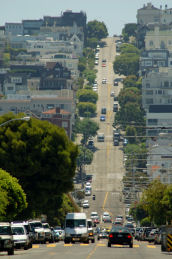Traffic may drive some people to diabetes
People with chronic inflammation may be especially vulnerable
Urban air pollution — especially the particles and gases spewed by heavy traffic — can increase a senior citizen’s risk of developing type-2 diabetes, according to a new German study. If confirmed, its authors say, pollution would represent a “novel and potentially modifiable risk factor” for the metabolic disorder.

And the putative mechanism: the chronic low-level tissue inflammation that pollution triggers.
Although inflammation can be a healthy response to acute infection, chronic inflammation can damage tissues and stress the body. Several studies have linked inflammatory pollutants with diabetes, although never, as here, in a long-running study where the participants started out healthy.
For their new study, Wolfgang Rathmann and his colleagues at the Leibniz Center for Diabetes Research at Heinrich Heine University in Düsseldorf analyzed data from 1,775 women — all around 55 years old and healthy when they entered the study 16 to 25 years ago. Most came from coal and steel regions in Germany, although some were recruited from small towns with little industry.
At entry and then again between 1990 and 2006, several biomarkers of inflammation were assayed in the women — notably complement factor C3, or C3c. It’s a protein produced by the liver in response to infection or other sources of inflammation. (The blood’s complement proteins get their name from the fact that they complement the work of antibodies by killing bacteria, producing inflammation and regulating other aspects of immunity.)
The new study also assembled data on the pollution to which the women had been exposed. In some cases, concentrations were measured directly, such as via urban air-monitoring stations; in other instances air pollution was inferred (based on the distance between a woman’s home and a heavily trafficked road).
Throughout the study, 187 participants developed type 2 diabetes. It’s the form that used to be called adult onset and occurs when the body becomes resistant to insulin, a hormone that helps the body move sugar out of blood and into cells where it fuels their activities.
All other things being equal, the more pollution a woman encountered, the greater was her chance of developing diabetes, the researchers report in Environmental Health Perspectives, published online ahead of print. However, blood concentrations of C3c appeared to play a major role in her vulnerability. Indeed, the researchers note, in most instances “an elevated risk for type 2 diabetes was only present in women with high C3c at baseline.”
That makes sense, Rathmann’s team says, because animal studies have linked pollution exposures and C3c’s parent molecule. In people, studies have linked elevated C3c with a heightened risk of developing diabetes. Indeed, they contend, it is “biologically plausible” that irritating air pollutants might trigger an immune response in the lung that “then spreads to other parts of the body and becomes apparent in chronically elevated levels of pro-inflammatory biomarkers in the circulation.”
This chronic inflammation might also create a vicious cycle, the scientists add, rendering affected patients increasingly vulnerable air pollution’s ravages.
One of the strongest environmental measures of diabetes risk, the new study found, was living within 100 meters of a heavily trafficked road — one over which 10,000 or more vehicles pass each day.
Rathmann’s group divided the participants into four groups based on the proximity of their homes to heavy traffic. And diabetes risk rose about 15 percent for each successive group as its proximity to traffic fell.
However, this link only held for participants with modest means. Wealthy recruits living on busy streets showed no similar vulnerability to diabetes.
I can imagine several reasons why. Well-heeled residents might choose apartments with better windows, ones that keep out most pollution. Or they might use air conditioning in summer instead of opening wide their windows. They might have lived on upper floors of high rises, well above pollution. Or they may have been more likely to have a car, which let them avoid walking along the street to shops or waiting at the street to catch buses — both of which would exaggerate exposure to traffic.
“To the best of our knowledge,” the authors say, “this is the first prospective, population-based study which showed a statistically significant association between traffic-related air pollution and incident type 2 diabetes.” The link “persisted when four different spatial scales were used to assess exposure levels and remained robust after adjustment for confounders,” they note, including obesity, income and exposure to several indoor air pollutants.
If pollution’s link to this disease is confirmed, Rathmann’s team argues, it might also help explain why diabetes is higher in urban areas than rural ones — something often seen when developing countries undergo rapid urbanization. In the past, urbanization’s link to diabetes had been attributed largely to accompanying lifestyle changes such as diet and physical activity.







